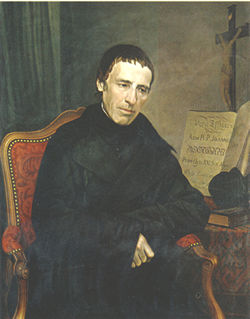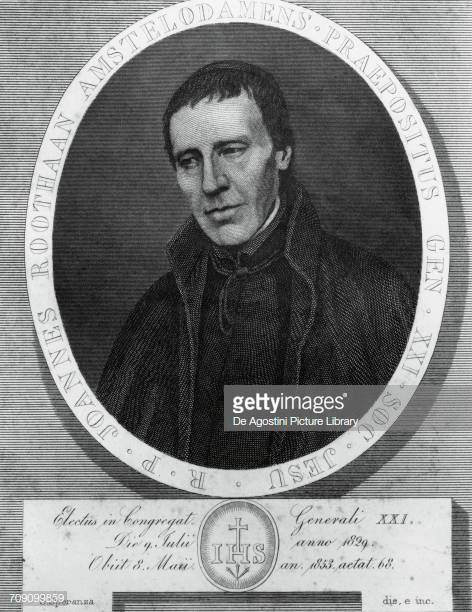May 8th - Servant of God: John Philip Roothaan, SJ
Born: November 23, 1785
Died: May 8, 1853
 Fr John Philip Roothaan, the twenty-first general of the Society of Jesus, was born in Amsterdam, Holland in 1785 when the Society was in its twelfth year of suppression due to political pressure from several European rulers. He received his elementary education in a classroom run by Fr Adam Beckers, a local parish priest who had been a Jesuit before the suppression. Fr Beckers gave him the foundations of a good education as well as spiritual guidance. At secondary school, John mastered Latin and Greek before he entered Amsterdam’s Athenaeum to do philosophy and Hebrew. When he heard from Fr Beckers that the Society still existed in White Russia (today’s Belarus) because Catherine the Great had forbidden the promulgation of the papal brief of suppression in her territories and that Fr Becker had recently been readmitted, John changed his mind about the diocesan clergy and decided to join the Jesuit novitiate in Dunaburg in White Russia instead, arriving there in June 1804.
Fr John Philip Roothaan, the twenty-first general of the Society of Jesus, was born in Amsterdam, Holland in 1785 when the Society was in its twelfth year of suppression due to political pressure from several European rulers. He received his elementary education in a classroom run by Fr Adam Beckers, a local parish priest who had been a Jesuit before the suppression. Fr Beckers gave him the foundations of a good education as well as spiritual guidance. At secondary school, John mastered Latin and Greek before he entered Amsterdam’s Athenaeum to do philosophy and Hebrew. When he heard from Fr Beckers that the Society still existed in White Russia (today’s Belarus) because Catherine the Great had forbidden the promulgation of the papal brief of suppression in her territories and that Fr Becker had recently been readmitted, John changed his mind about the diocesan clergy and decided to join the Jesuit novitiate in Dunaburg in White Russia instead, arriving there in June 1804.
Fr Roothaan was ordained on Jan 27, 1812 and went to Pusza (today’s Latvia) as the Jesuits had to disband because Napoleon’s army was on its march to Moscow. Fr Roothaan taught Latin and Greek to young Jesuit scholastics in the temporary juniorate set up. He was later appointed preacher in the Jesuit church attached to the college in Orsza. Although Napoleon was defeated and Pope Pius VII had restored the Jesuits in 1814, Fr Roothaan stayed on in White Russia until the Jesuits were expelled by Tzar Alexander I in 1820. Leaving his Polish Jesuits after fourteen years with them, Fr Roothaan arrived in Brig, Switzerland with a group of exiled scholastics.
At Brig, Fr Roothaan taught classics to the scholastics and after he had mastered the German language he started giving missions in the rural parishes throughout the canton. Three years later he was appointed by Fr General Luigi Fortis to be rector of a college in Turin, Italy and during his six years there, the college flourished and the student enrolment grew from 30 in 1823 to 200 in 1829. In Feb 1829, Fr Roothaan was called upon to take on a more important role. Fr Fortis had just died and the Italian provincial Fr Vincenzo Pavani was named vicar general. Since the latter had to guide the Society until a new general was elected, he appointed Fr Roothaan vice-provincial of Italy. Though considering himself insufficiently trained for his new task, he obediently assumed the post in March 3, 1829.

In July of the same year when the Society’s delegates met to elect the new general, Fr Roothaan was not yet forty-four years old and was the second youngest in attendance. To his amazement, he was elected the Society’s twenty-first general on July 9, 1829 and was given the task of rebuilding the Society to the status it was prior to its suppression. During his twenty-four years as general, Fr Roothaan placed great emphasis on St Ignatius’ Spiritual Exercises as the key to reorganizing the Society. He published a new edition of the Exercises (1835) and wrote a commentary on them (1838). To help his Jesuit brethren gain the most from them, he wrote a booklet “On Meditation” (1836) which was very popular among Jesuits. To strengthen the Jesuit school system, he revised its code of education, “Ratio Studiorum” (1832) and was instrumental in opening several important colleges in the US, like Fordham in the Bronx, Holy Cross in Worcester, St Joseph’s in Philadelphia, Loyola in Baltimore, and St Louis University in St Louis. Fr Roothaan had similar concern for the work of the Society in Calcutta, India and sent missionaries to Algeria, Egypt, and Australia.
Under Fr Roothaan’s twenty-four years of guidance and leadership, the Society expanded and was well on its way to being what it once had been. By 1853, Fr Roothaan was sixty-seven and his strength diminished and he had slowed down and began to walk with a stoop. On Feb 7, 1853, he suffered a cardiac affliction and was in constant pain for three months. However those attending to him only heard words of resignation and surrender to God from him. On May 7, he again suffered severe chest pains on his right side. The following morning when it was clear that he was dying, his Jesuit brethren gathered in his room to commend his soul to God. As he recited the invocations of his favourite prayer “Soul of Christ”, he died peacefully in the hands of the Lord.
Fr John Roothaan’s cause has been introduced in Rome. Fr John Philip Roothaan, the twenty-first general of the Society of Jesus, was born in Amsterdam, Holland in 1785 when the Society was in its twelfth year of suppression due to political pressure from several European rulers. He received his elementary education in a classroom run by Fr Adam Beckers, a local parish priest who had been a Jesuit before the suppression. Fr Beckers gave him the foundations of a good education as well as spiritual guidance. At secondary school, John mastered Latin and Greek before he entered Amsterdam’s Athenaeum to do philosophy and Hebrew. When he heard from Fr Beckers that the Society still existed in White Russia (today’s Belarus) because Catherine the Great had forbidden the promulgation of the papal brief of suppression in her territories and that Fr Becker had recently been readmitted, John changed his mind about the diocesan clergy and decided to join the Jesuit novitiate in Dunaburg in White Russia instead, arriving there in June 1804.
Fr Roothaan was ordained on Jan 27, 1812 and went to Pusza (today’s Latvia) as the Jesuits had to disband because Napoleon’s army was on its march to Moscow. Fr Roothaan taught Latin and Greek to young Jesuit scholastics in the temporary juniorate set up. He was later appointed preacher in the Jesuit church attached to the college in Orsza. Although Napoleon was defeated and Pope Pius VII had restored the Jesuits in 1814, Fr Roothaan stayed on in White Russia until the Jesuits were expelled by Tzar Alexander I in 1820. Leaving his Polish Jesuits after fourteen years with them, Fr Roothaan arrived in Brig, Switzerland with a group of exiled scholastics.
At Brig, Fr Roothaan taught classics to the scholastics and after he had mastered the German language he started giving missions in the rural parishes throughout the canton. Three years later he was appointed by Fr General Luigi Fortis to be rector of a college in Turin, Italy and during his six years there, the college flourished and the student enrolment grew from 30 in 1823 to 200 in 1829. In Feb 1829, Fr Roothaan was called upon to take on a more important role. Fr Fortis had just died and the Italian provincial Fr Vincenzo Pavani was named vicar general. Since the latter had to guide the Society until a new general was elected, he appointed Fr Roothaan vice-provincial of Italy. Though considering himself insufficiently trained for his new task, he obediently assumed the post in March 3, 1829.
In July of the same year when the Society’s delegates met to elect the new general, Fr Roothaan was not yet forty-four years old and was the second youngest in attendance. To his amazement, he was elected the Society’s twenty-first general on July 9, 1829 and was given the task of rebuilding the Society to the status it was prior to its suppression. During his twenty-four years as general, Fr Roothaan placed great emphasis on St Ignatius’ Spiritual Exercises as the key to reorganizing the Society. He published a new edition of the Exercises (1835) and wrote a commentary on them (1838). To help his Jesuit brethren gain the most from them, he wrote a booklet “On Meditation” (1836) which was very popular among Jesuits. To strengthen the Jesuit school system, he revised its code of education, “Ratio Studiorum” (1832) and was instrumental in opening several important colleges in the US, like Fordham in the Bronx, Holy Cross in Worcester, St Joseph’s in Philadelphia, Loyola in Baltimore, and St Louis University in St Louis. Fr Roothaan had similar concern for the work of the Society in Calcutta, India and sent missionaries to Algeria, Egypt, and Australia.
Under Fr Roothaan’s twenty-four years of guidance and leadership, the Society expanded and was well on its way to being what it once had been. By 1853, Fr Roothaan was sixty-seven and his strength diminished and he had slowed down and began to walk with a stoop. On Feb 7, 1853, he suffered a cardiac affliction and was in constant pain for three months. However those attending to him only heard words of resignation and surrender to God from him. On May 7, he again suffered severe chest pains on his right side. The following morning when it was clear that he was dying, his Jesuit brethren gathered in his room to commend his soul to God. As he recited the invocations of his favourite prayer “Soul of Christ”, he died peacefully in the hands of the Lord.
Fr John Roothaan’s cause has been introduced in Rome.
